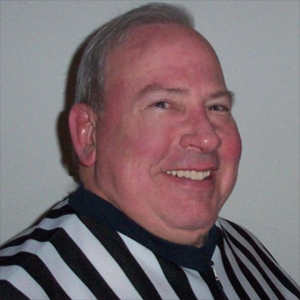
Rndballref
20 Years Experience
Chicago, IL
Male, 60
For twenty years I officiated high school, AAU and park district basketball games, retiring recently. For a few officiating is the focus of their occupation, while for most working as an umpire or basketball referee is an avocation. I started ref'ing to earn beer money during college, but it became a great way to stay connected to the best sports game in the universe. As a spinoff, I wrote a sports-thriller novel loosely based on my referee experiences titled, Advantage Disadvantage
Backcourt violation is the correct call because a player who catches the ball while in the air is considered to be in the court position from where they last touched the court. For example, if a player is out of bounds and leaps up, as soon as the player touches the ball it should be whistled dead on an out of bounds violation.
In your question if an offense player leaps from the backcourt to touch a ball which has been established in his team's front court it is a backcourt violation. Two exceptions to this rule: 1) on a throw-in, a player can jump from either side of the centerline, catch the throw in and land on the opposite side, and 2) a defensive player who leaps from his backcourt to intercept a ball which came from his front court (which was in possession of the offense before the interception).
Boxing out is the process of legally getting to a spot on the floor before an opponent gets to the same spot. Most people think of this when you achieve inside rebounding position, and you are able to anticipate your opponent's movement in such a way that you prevent him from moving around you by "blocking" his way. Note this definition is without specification regarding a shot or no shot.
In my experience, the player blocking out is tagged with a foul when he blatantly backs up and dislodges his opponent when making contact, but not usually when both players move laterally.
Player B is awarded the points for the free throws he makes. There are no points awarded for drawing a foul - at least not in NFHS rules.
In NFHS rules, the three second restriction is lifted when a legitimate try for the basket goes up. Note that it does not say "when the ball hits the ring". So the first part of your question's answer is no, there is no three second violation because once a try goes up there is no team possession anymore. Secondly, in NFHS rules any player can retrieve an air ball shot as long as it was deemed a legitimate try. Once retrieved, team and player possession are reestablished, and he gets a new 3 second count if he is still in the lane.
Investment Banker
 What's the craziest partying you've ever seen among bankers?
What's the craziest partying you've ever seen among bankers?
CPR Trainer
 Just how effective is the Heimlich, really?
Just how effective is the Heimlich, really?
Casting Director
 What do you look for when auditioning candidates for reality TV?
What do you look for when auditioning candidates for reality TV?
I would warn the player that blowing air in the face of an opponent is unsportsmanlike and the next occurance would be a technical foul.
In NFHS rules each technical is 2 free throws and the ball. If the official awarded 4 free throws then I assume 2 technicals were called.
I am not an expert on AAU rules but common sense would tell anyone to avoid officiating your son's game in competitive play. It would be different if it was a "house" league, but this is inappropriate for traveling basketball.
-OR-
 Login with Facebook
Login with Facebook (max 20 characters - letters, numbers, and underscores only. Note that your username is private, and you have the option to choose an alias when asking questions or hosting a Q&A.)
(A valid e-mail address is required. Your e-mail will not be shared with anyone.)
(min 5 characters)
By checking this box, you acknowledge that you have read and agree to Jobstr.com’s Terms and Privacy Policy.
-OR-
 Register with Facebook
Register with Facebook(Don't worry: you'll be able to choose an alias when asking questions or hosting a Q&A.)